After spending a month living in Lebanon with a local family, I had many opportunities to really get to know the food of Lebanon. Prior to traveling there, I didn’t really know much about Lebanese food. However by the time I left, I was in love with all of the Mediterranean flavors and such fresh foods. I loved going to the markets and restaurants learning about the different dishes!
Even in times of peace in Lebanon there is still a war raging. Lebanon battles it’s Arab neighbors for the title of ‘Creator of Hummus’. They even went as far as trying to copyright it! This battle has raged on for years, and still no real resolution as to who the real creator of hummus is. In May 2010, the Guinness World Record awarded Lebanon with the largest dish of hummus in the world. The winning dish, cooked by 300 cooks in the village of al-Fanar, near Beirut, weighed 10,452 kg (22,994 lbs, equal to 11.5 U.S. tons). Yes, that’s right, the Lebanese are serious about hummus; actually the Lebanese are serious about food…period.
Table of Contents
Mediterranean Food Origin is Shared Between Many Countries
This fight over hummus surprised me considering I had always thought Greece was the creator of hummus. After all, it’s what’s on every Greek restaurant menu. However my time in Lebanon taught me something very important; hummus, tabouleh, dolma, and falafel are simply Mediterranean food. And since Lebanon is on the Mediterranean then food in Lebanon is also dominated by these staple dishes.
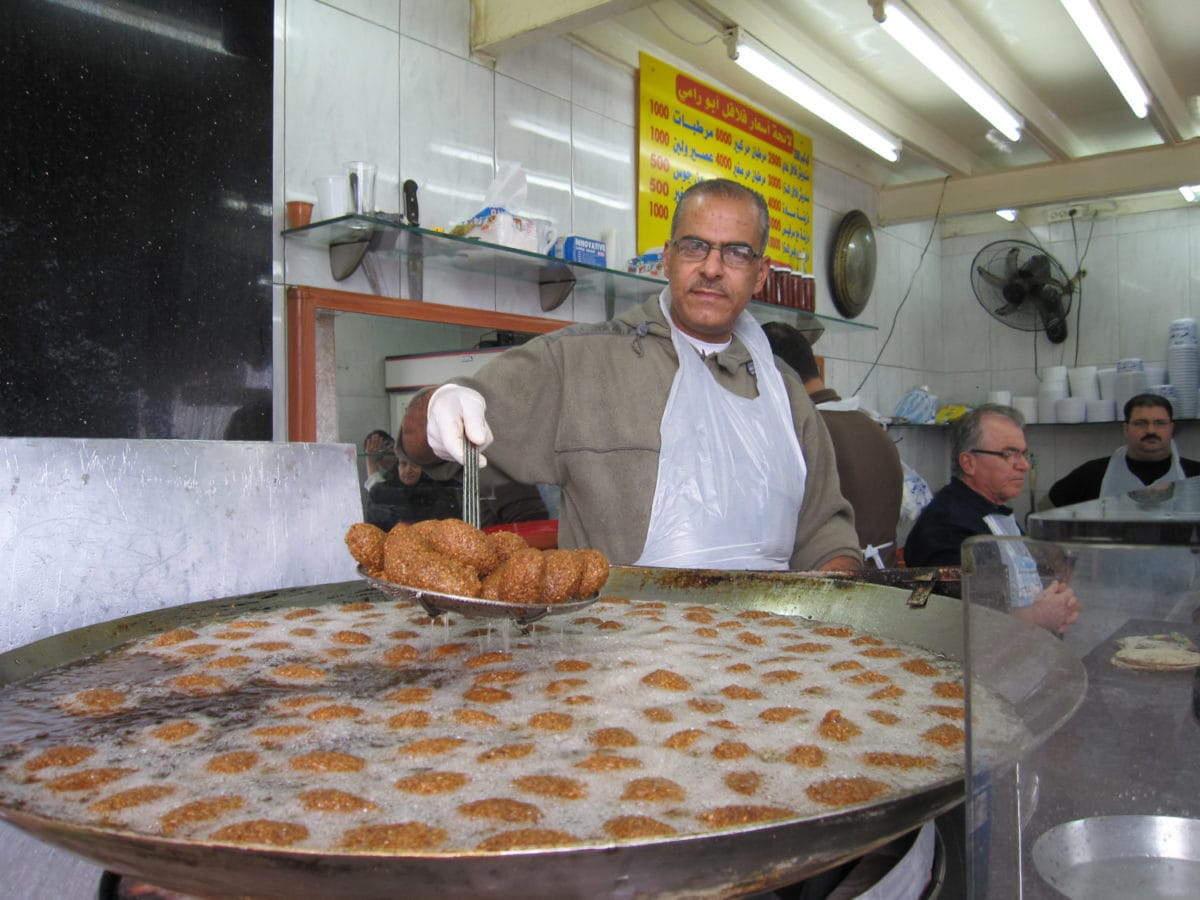
Lebanese Food Culture
When I arrived, I clearly wasn’t very well versed in Lebanese food, but many of my foodie friends such as Alison from Cheeseweb and Lisa from LLWorld Tour had raved to me about Lebanese food, so I was eager to try it. Even though my host mom, Mira, told me she didn’t cook much, I was still able to get a taste of daily cooking in Lebanon thanks to her kind neighbors. They brought dishes by daily for me to try; what treatment!
If that wasn’t enough, I was also often invited to dinner at people’s homes and treated like a visiting child from college getting showered with attention and food. I was even sent home with leftovers!
The Lebanese, like Jordan, have that incredible ‘guest culture’ that makes me love the middle east. They want you to love their culture and their country. And they know the fastest way to someone’s heart is through their stomach!
The Mediterranean Food Basics You’ll Find in Lebanon
Tabouleh, hummus, falafel, and shwarma are the staples that we are all familiar with and most of us have probably tried before. To be in the land where these items were originally created is a true treat. One of the key ingredients that I would see over and over in Lebanese food was mint. It dominated everything from salads to sandwiches giving everything a fresh taste. A simple sandwich of cucumber, tomato and mint was common for lunch.
Fattoush was also a common salad eaten weekly. It was simple, fresh, and green; filled with cucumber, parsley, tomato, and green onions. But my favorite was of course the falalfel with it’s tangy white sauce and handfuls of mint.


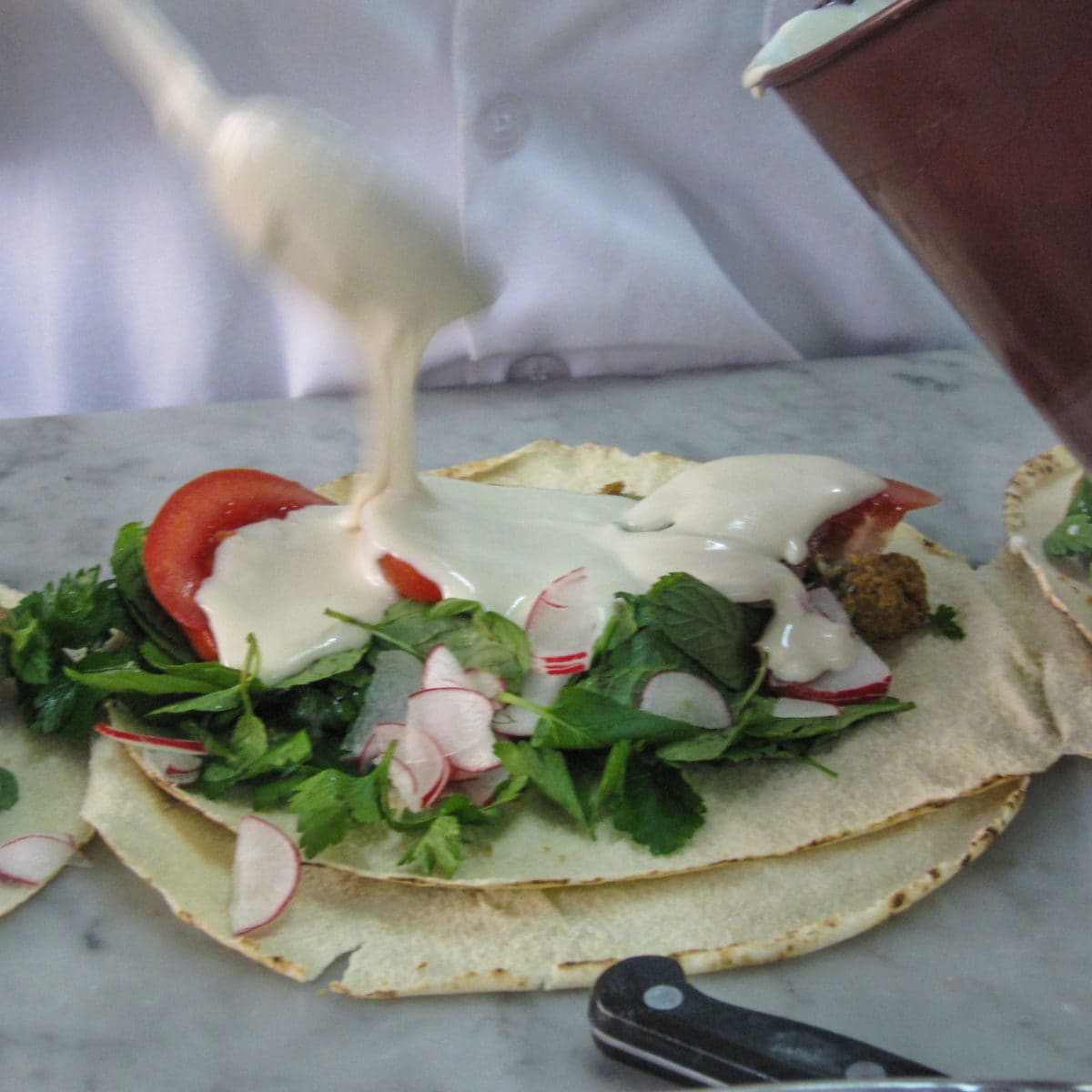
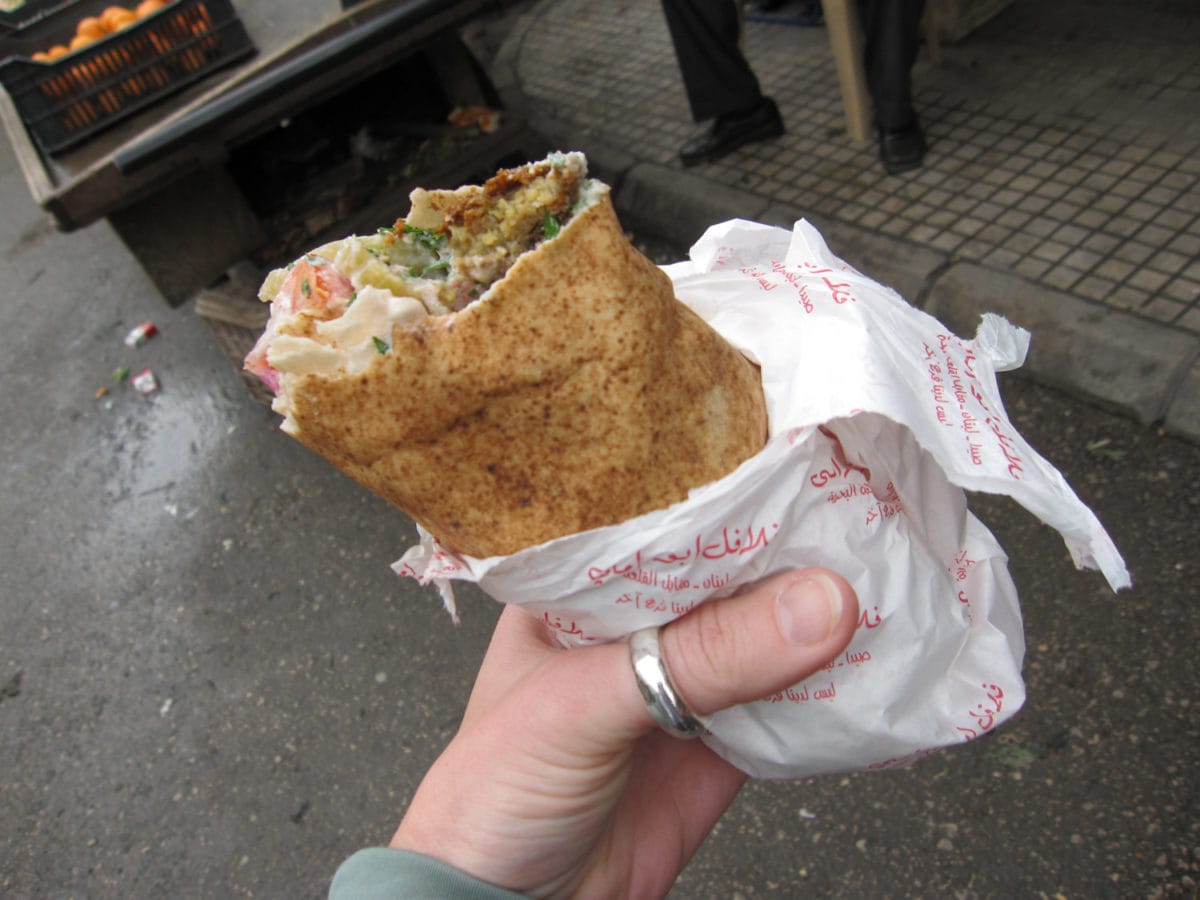
Lebanese Bread
Much like Jordan, bread was a dominant player in everyday food of the Lebanese. It came in all shapes and sizes, but my favorite was the ka’ak bread. It immediately caught my eye the first day I was walking around Beirut when a bicycle vendor was parked by a big traffic circle with stacks of something that looked like handbags hanging from hooks. Upon closer look, I realized it wasn’t brown leather handbags, instead it was bread! Sesame covered bread that was puffed up and shaped like a handbag.
Ka’ak refers to a bread made in a large ring-shape and is covered with sesame seeds. Fermented chickpeas are used as a leavening agent. Ka’ak is meant to be eaten warm, hot out of the oven; I preferred to have some cheese slathered on the inside of the hot steaming bread which made for a delicious snack.

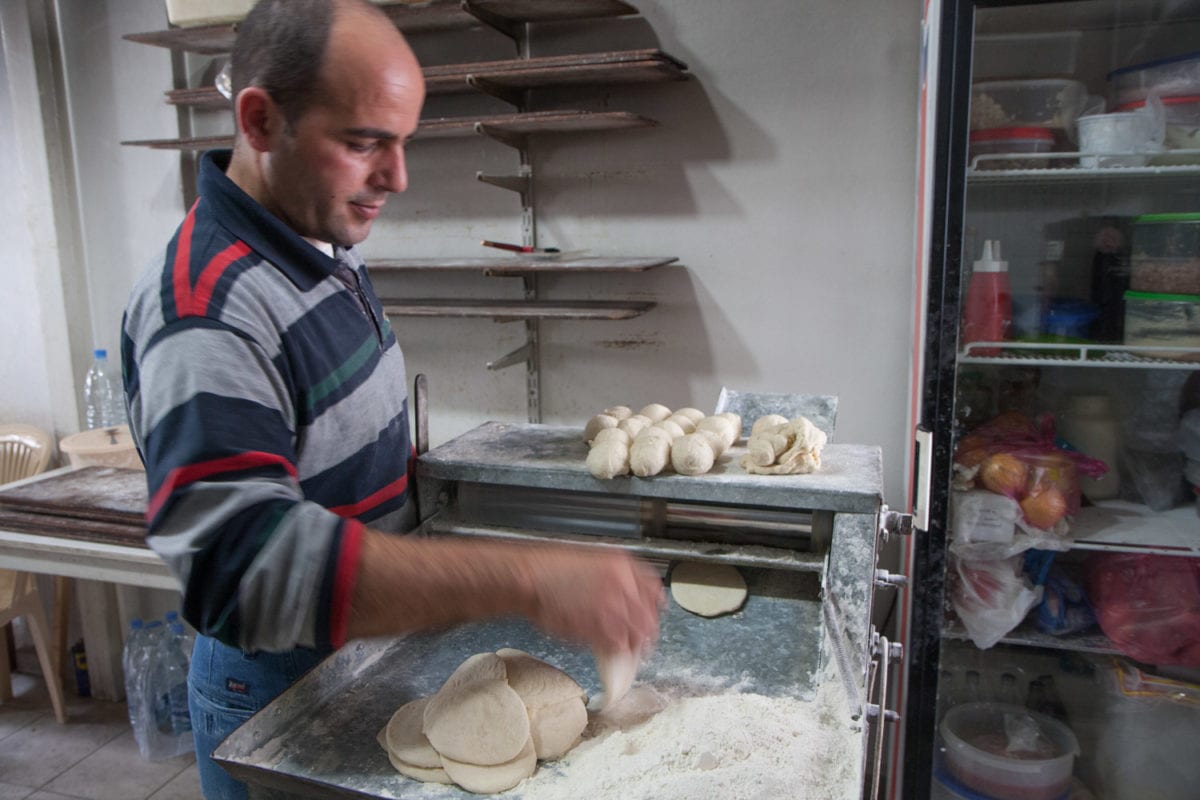
Breakfast Food in Lebanon
The first morning in Beirut my host mom ordered manoushe for breakfast; it was my first of many manoushe that month, but I enjoyed every one of them! Manoushe is a thick, slightly sweet bread with olive oil and za’atar. Za’atar is the commonly seen spice in the Middle East – a mix of dried herbs (thyme, sesame seeds, oregano, and sumac), that you could smell from far away.
The manoushe was quite often served with lebne and za’atar for breakfast. This delicious morning meal was my go to choice! Lebne is a tangy yogurt cream cheese that you can spread on anything! It’s made by simply removing the water/liquid from regular yogurt by hanging in a cheesecloth from the sink for a day or two. Once again, the manoushe was best if it was warm out of the oven coupled with a fresh squeezed glass of orange juice for breakfast.

For those with a breakfast sweet tooth, then you can opt for knafeh. I quickly learned that the Lebanese knafeh was vastly different than the Jordanian knaffe. First of all, Jordanians eat knafeh for dessert only, but the Lebanese eat it for breakfast…in between sesame buns.
Imagine a piece of cheesecake, dipped in honey and then put between two sesame seed hamburger buns. Sounds like a stellar breakfast –right?! The Lebanese put the knafeh between bread to cut the uber sweet/rich taste of the knafeh alone. I tried the Lebanese knafeh one morning and it was certainly a treat. I don’t even want to know how many calories are in knafeh! Even my American sweet tooth felt this was quite a lot of sugar for breakfast! Lebanese coffee was absolutely necessary with this sweet breakfast…oh darn.


Beans used in Lebanese Food
Beans are also a big staple in Lebanese food. Foul (pronounced fool), a bean dip, was a favorite as well as hummus. However, I did get the chance to try a new bean dish I had never heard of before – Fateh. While in Tripoli my host took me to a restaurant that was known for it’s foul and fateh. This was my first time eating fateh and it was a pleasant surprise to by tastebuds.
It was one of the few foods in Lebanon you actually ate with a spoon and not with bread. Instead, the bread was actually at the bottom of the bowl and then covered with yogurt, melted butter, garbanzo beans, and roasted nuts on top; served slightly warm. The buttery warm taste was delicious. Really…can you go wrong with butter? I think not.
Lebanese Spices
Of course I already mentioned that king of spices in the Middle East – za’atar, however one of my favorite things about Lebanese cooking is that they use spices differently than we do in America. They tend to use spices that we only reserve for special occasion meals of desserts in their everyday meals. Specifically you’ll taste a hints of cinnamon, nutmeg, and cloves in most of their dishes. I especially was fond of the kebbeh spiced meatballs. Every time I bit into one it reminded me of American Thanksgiving!
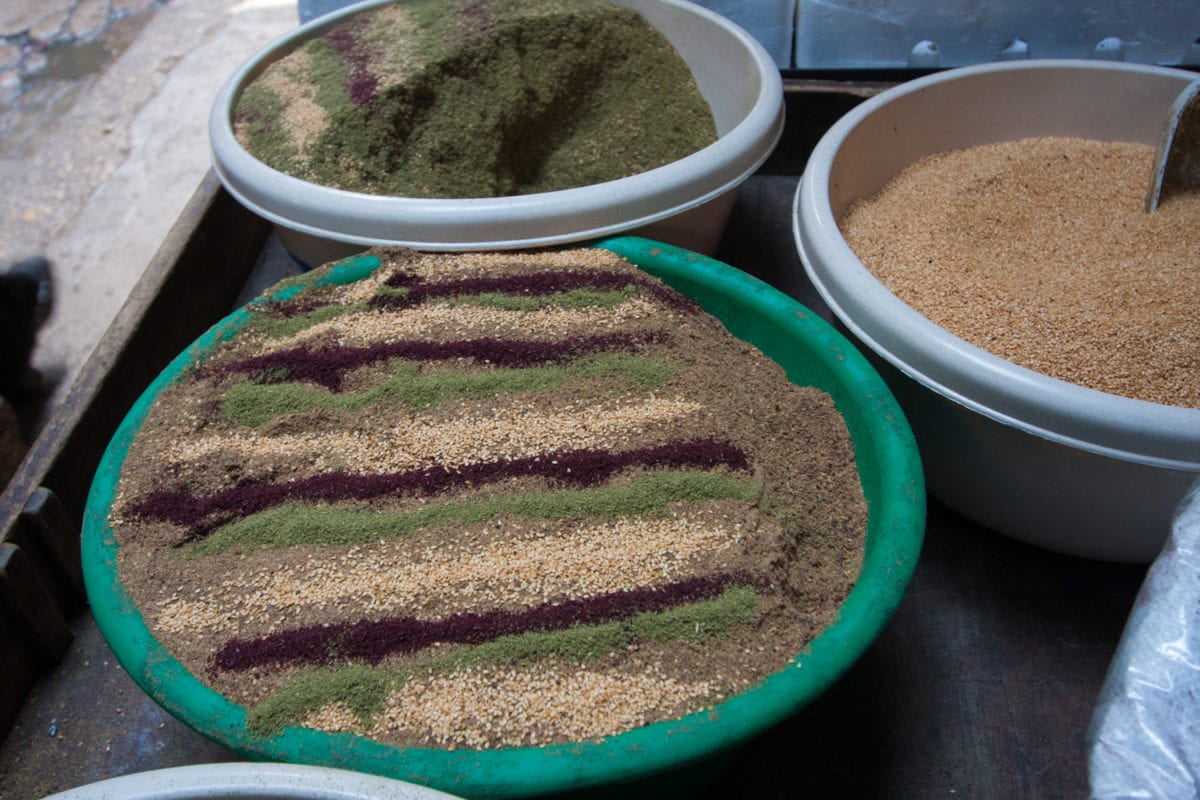
Mezze Snacks
In general, the Lebanese snacked a lot with little small plates (called mezze) of these famous dishes that everyone shared around the table. A typical Mezze may consist of salads such as the Tabouleh and Fattoush, together with dip such as Hummus, Baba ghanoush or Moutabal, Kebbeh and finally stuffed grape leaves.
But one other thing that I fell in love with in the snack category was brought to your table when you ordered a drink in a bar – carrots. I know, carrots don’t sound too exotic…but they would bring out a little glass of carrots in a lemon juice and set them on your table next to a bowl of nuts. You can have a beer and carrots…sounds strange, but it’s much healthier than peanuts.
Another non-food tradition in Lebanon was smoking a hooka pipe. It’s a big part of the socializing culture. Learn more about the entire industry behind the hooka pipe culture.
Lebanese Sweets
Lebanon was full of sticky sweet pastry shops, especially in Tripoli. As I walked around the souks in Tripoli I was offered plenty of samples of these sweet, nutty concoctions. I was also offered cakes which had hints of rosewater in it giving it this unique taste that I immediately fell in love with. Saida also was known for it’s pastries and I returned from Saida with a plate of coconut and nugget bars that my teeth didn’t like, but my stomach loved.
While in Taaynayel I had the opportunity to try a special dessert calle Meghli. Meghli is a Middle Eastern rice pudding made with rice flour and flavored with cinnamon, aniseed and caraway. Served in small bowls, the pudding is topped with blanched almonds, pistachios and pine nuts. Meghli was not only full of yumminess, it was full of tradition. It is served to celebrate a newborn in the family. It’s also considered a Christmas dessert with the idea that Christ was a newborn! Regardless of traditions, I would eat this dessert anytime; I love rice pudding, so Meghli was a slam dunk for me. I even found a good meghli recipe to make it at home.



Comfort Food Shish Barak
Every country has comfort food – the food that makes you think of home and a feeling of well-being. Even though my host mother, Mira, said she didn’t cook I did find her in the kitchen a few times painstakingly making shish barak.
Shish barak are dough balls stuffed with ground beef and spices and cooked in a yogurt sauce. It’s sort of like yogurt soup and is seen as a comfort food; similar to mac and cheese for Americans. She made the dough balls by hand in a process that reminded me of Italy as I watched her fold each one just right. The wee little tortellini like dumplings can take a bit of time, what with the rolling, shaping, crimping and baking…and Mira stopping to insist to me that she indeed did not cook…while her hands were covered with flour.



The food of Lebanon lived up to it’s reputation for me. But I think the best thing about my month of eating is that 80% of it was with locals in their homes. I only went to restaurants a handful of times and quite frankly the local meals were by far the best!
If you are looking for a great foodie destination to travel to, then put Lebanon on your list! And find a Lebanese mother to adopt you for a while – I have a few that would be willing to cook for you non-stop!
What are your favorite Lebanese dishes?







By Theodora April 7, 2011 - 8:28 am
Every Mediterranean country pretty much claims hummus. Egypt, Israel, Turkey, Greece — and Jordan too. Lovely stuff.
By Sherry April 7, 2011 - 6:52 pm
I don’t care who claims it…just so they keep making it! 🙂
By Sophia September 27, 2015 - 8:58 pm
Greeks dont eat hummus
By Abigail April 7, 2011 - 2:28 pm
I’ve never had Lebanese food but these pictures make me want o go search for some, but I doubt it will be as good as you had. By the way how did you find your host mother? Was it through your own research or a recommendation?
By Sherry April 7, 2011 - 6:52 pm
I was actually staying with local families in both Lebanon and Jordan through GeoVisions – http://www.geovisions.org . They do these great cultural exchange programs where you live with a host family and tutor them in English for a month. I’ve found it to be one of my preferred ways to travel! It really allowed me to dig into the culture in a way that I don’t get to do as a typical tourist or backpacker.
By Abigail April 7, 2011 - 8:06 pm
Wow thanks for the help. I checked the website out and it looks pretty interesting.
By Dalene - Hecktic Travels April 7, 2011 - 9:52 pm
A cheesecake sandwich! Sounds like my kind of place.
And I’m with you – who cares who invented hummus…just gimme some! 🙂
Thanks also for the geovisions tip, I will be looking into that as well!
By Sherry April 16, 2011 - 1:13 am
Darlene – Let me know if you have any questions about GeoVisions – happy to provide my opinions!
By Nicole April 8, 2011 - 9:25 am
I want to eat in Lebanon! Yum!
By Mark H April 11, 2011 - 6:19 pm
I have a Lebanese shop within walking distance of my home in Sydney. My favourites are the various dips with Lebanese bread. Enough for a casual meal…
By Rebecca April 17, 2011 - 7:24 am
Mmmmmm. That is all!
By Georgia November 24, 2013 - 1:26 pm
I am Armenian, we eat the same…HAMOVE!!!
By Dani May 29, 2018 - 9:59 pm
It is so true about all he wrote. I am Lebanese and I cook at home. Have a food truck for Lebanese cuisine and still I go to Lebanon just to eat nothing else.
By Lucinda Paine November 28, 2018 - 9:49 pm
Lebanese food is one of the healthiest and enjoyable food to try if you are traveling in the Middle East.
By Sherry November 29, 2018 - 6:16 pm
Yes – it’s delicious!!
By Ishbilia June 20, 2019 - 7:29 am
Hello Admin, this blog is interesting, elaborated and informative about the food of Lebanon. Lebanese food is Levantine style of cooking which includes whole grains, veggies, starches, fresh seafood. Thank you for posting your work here. Cheers!
By Tori November 21, 2019 - 5:56 am
Great review, thanks for sharing. The food looks very appetizing. Beautiful photos!